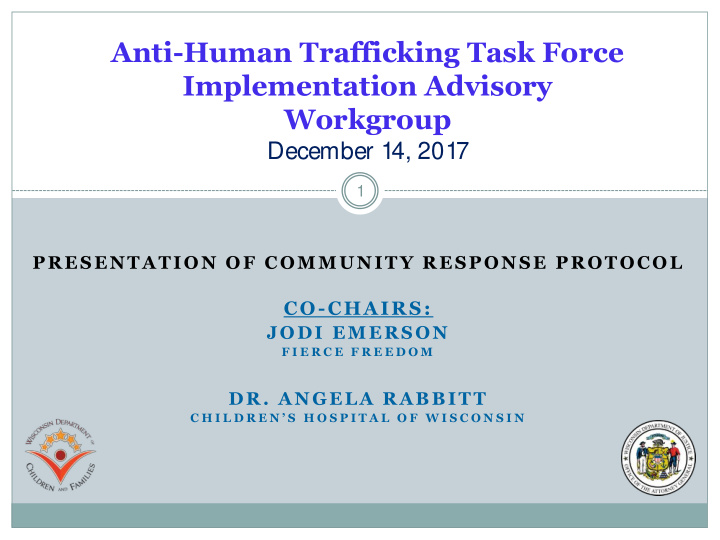



Anti-Human Trafficking Task Force Implementation Advisory Workgroup December 14, 2017 1 PRESENTATION OF COMMUNITY RESPONSE PROTOCOL CO-CHAIRS: JODI EMERSON F I E R C E F R E E D O M DR. ANGELA RABBITT C H I L D R E N ’ S H O S P I T A L O F W I S C O N S I N
Presentation Overview 2 Workgroup charge Phase 1 Phase 2 Questions and answers
Implementation Advisory Workgroup Charge 3 Expert cross-system feedback will be given on state- created protocols that guide the implementation of anti-human trafficking programs and policies. Members will also advise on the implementation of previous workgroup recommendations for training, identification, and prevention efforts.
Workgroup Phase 1 4 Review and feedback on deliverables from other workgroups Identification and screening tools Training materials Prevention curricula DCF and regional hub materials
Workgroup Phase 1: Indicator & Screening Tools 5 Provided recommendations regarding clarity and content of the indicator tool (Wisconsin Child Sex Trafficking and Exploitation Indicator and Response Guide) Provided recommendations for wording and utilization of the screening tool to ensure: It is clear that the tool is not a checklist, but a guide on the types of questions to use when assessing risk It is used by professionals with training in the core competencies Discussed mechanisms for integrating tools into agency trainings and processes
Workgroup Phase 1: Training Curriculum 6 Reviewed modules to ensure that they align with the Core Competencies and represent accurate information Discussed how to make the training applicable to a variety of learners Module 6 should be grouped into discipline-specific categories Recommended strategies to incorporate screening and indicator tools into trainings Include discipline-specific information where possible Suggested a short module for screening tool Assessment of screening tool
Workgroup Phase 1: Other Training Options 7 Recommended in- person training/Speaker’s Bureau to develop a group of trained presenters in each discipline Medical Law enforcement and corrections, courts Mental health/ AODA providers Social services/ CPS Education Out-of-home care providers Tribal Advocates Also suggested other venues where the awareness and indicator information can be shared (e.g., hotels, transportation, beauty parlors)
Workgroup Phase 1: Prevention Curricula 8 Reviewed the highlights of each curriculum and what aligned with the Department of Public Instruction (DPI) practices Explored opportunities for implementation in agencies Determined that iEmpathize most closely aligns with current practices in schools
Workgroup Phase 1: DCF materials 9 Reviewed and gave feedback on documentation created by the Department of Children and Families (DCF) for use in the regional hubs and counties Understanding the Child Welfare Response to Sex Trafficking of Children and Youth Discussion with regional hub representatives from Outagamie County Department of Health and Human Services
Workgroup Phase 2: Community Response Protocol 10 Process to developing a coordinated community response document Emergency placement for youth being trafficked was recurring theme in our meetings Agreed that complicated systemic changes are needed Explored a wish list that the Task Force could recommend Drafted a needs statement in regards to what services communities could and should offer
Overview of Community Response Protocol 11 This is the wish list or ideal situation Gives communities a place to start working Living document, changes will be occurring to this document Includes best practices and recommendations for each section
Overview of Community Response Protocol 12 Introduction and overview of trafficking Words matter What is trafficking? Who can be trafficked? Who are the traffickers? What make trafficking cases different? Why now?
Overview of Community Response Protocol 13 Elements of an effective Community Response Prevention Resilience Engagement and Identification and and Recovery protection Restoration
Overview of Community Response Protocol 14 Services Needed Mental Health Emergency Support and and Crisis Housing Advocacy Stabilization Caregiver Medical Care Peer Support Support Employment Educational Legal Support and Job Support Training
Overview of Community Response Protocol 15 Other items included in document State level response Terms and definitions Guiding Principles Core Competencies
Future Considerations 16 Continue more in-depth discussions about ways to 1. improve emergency housing options across the state 2. Create a case mapping of how to walk through a case (if- this-then-that) 3. Expand legal knowledge of trafficking 4. Chart or visual implementation of a case study so that professionals know where they fit in Guidance on how to build a local task force 5. 6. Addressing gap of services being delivered on a timely basis Promote reconfiguration of how interested stakeholders 7. can connect with each other in the future
Future Considerations 17 8. Coordinate identification and response guidelines among school districts 9. Coordinate Task Force recommendations with the legislature’s foster care listening sessions 10. Discuss appropriate placement settings for youth with complex needs 11. Explore the creation of more level 5 homes 12. Explore the intersection of psychiatric facilities and residential care centers (RCCs) and safety related concerns
Questions 18 Feedback from Task Force members Additional items to explore in 2018 and beyond?
Thank you to our workgroup members! 19 Co-chairs: Jodi Emerson & Dr. Dawn Bucholz Angela Rabbitt Bridget Bauman Robin Stuht State staff lead: Allison Budzinski Claudine O’Leary Jan Miyasaki Carrie Anderson Pam Cotton Erika Petty Dan Magnuson Pam Carper Steve Gilbertson Leah Thaldorf Dana Dorn Nancy Irizarry Eric Underly Penny Nevicosi Sr. Carol Haanen Sgt. Paul Hestekind Honorable Mike Dwyer Morgan Young Ian Henderson Shira Phelps Tim Baack Christie Gause-Bemis Stephanie Reilly Sarah Coyle Mariana Rodriguez Dr. Joy Ippolito Lt. Steve Elliott
Recommend
More recommend